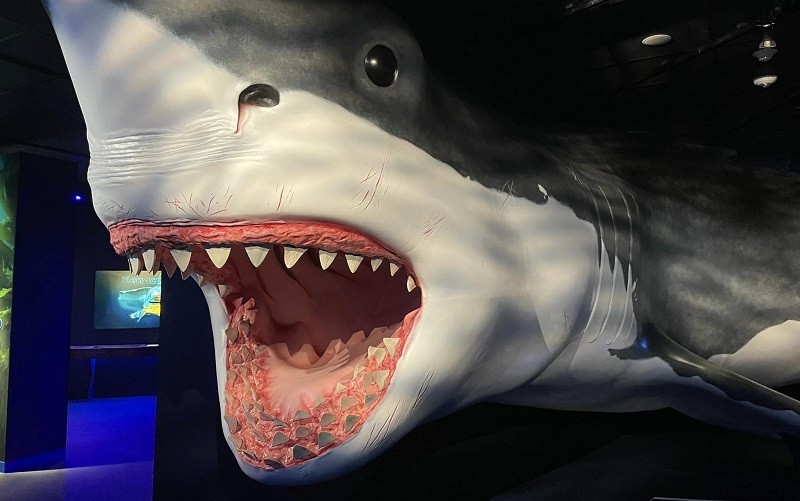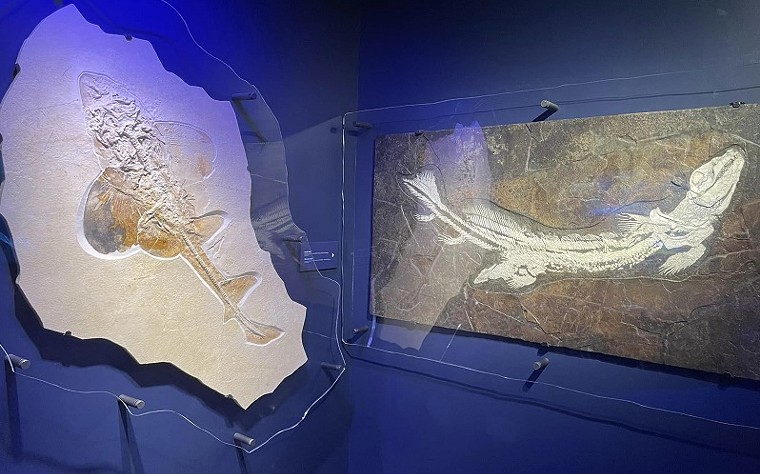A new exhibit celebrating the apex predators of the sea opens today at the Houston Museum of Natural Science. It’s called Sharks!, with an exclamation point. Just to make sure visitors get the message, a giant inflatable shark named Marissa now adorns the outside of the building.
The basement of the museum is a place where the dregs of their collection usually go. One thing I was worried about was that the exhibit would be a shoddy, cobbled together attempt to house some of the shark artifacts that have been randomly displayed around the building for decades. Instead, Nicole Temple, curator of sharks and vice president of education, has helmed an entire undersea adventure that lives up to the slick, high-tech offerings the HMNS has become known for. She knows that sharks are both super popular and also the subject of tremendous misinformation.
“Google ‘shark’ and the first thing that comes up is a Great White leaping out of the water with a mouth full of teeth,” she says. “But, they are ecologically diverse and incredibly important to the ocean’s health. We need the ocean to be healthy. It’s a huge carbon sink. If the ocean isn’t healthy, all the damage we do through climate change gets worse.”
For sure, there are some dramatic and terrifying aspects to the exhibit. A life-sized megalodon snakes through the shimmering blue halls. It’s not a garish as nine years ago wen the museum screened portions of Sharknado, but it’s still clearly going for the thrill factor.
More bizarre is a large wall display that carefully quizzes visitors on how sharks are rarely dangerous and almost never attack. On the opposite wall is set of screens with signs that say not to tap on the glass. I, in the interest of journalism, tapped on the glass until a CGI shark rammed the display and made me scream loud enough that museum officials came to see if I was okay.
So, yeah. A bit of sensationalism, but there is also plenty of actual science. For instance, the museum has a corner dedicated to evolution’s alpha builds of the shark, including helicoprion, edestus, stethacanthus, and xenacanthus, all renowned for their bizarre jaws and head shapes. As most people have the Great White burned into their minds as the platonic ideal of a shark, it was interesting to see fossils and deep explorations of these earlier, weirder fish.
There is also a megalodon poop. That is something you don’t run into every day, thank God.
One aspect of the HMNS that continues to amaze is their dedication to accessibility. Not only are all the displays in English and Spanish, but they are designed to allow wheelchairs to fit under them and are backlit for the visually impaired. Making the museum a place for everyone has been a top priority over the last several special exhibits, and it shows.
Finally, there is a touch tank in the back where visitors can run two fingers along the backs of bamboo or epaulette sharks. Stephanie Bradbury, head of animal programing, was on hand, and we discussed what she learned since the last time the museum had a shark touch tank.
“I learned they’re really picky,” she said, gesturing at the epaulette, hammerhead shark tattoo blazing on her wrist. “You give them a little bit of food, and they hold it in their mouths then spit it out. You have to cut it up tiny for them or they go on hunger and touch strike. They’ve been splashing me all day!”
According to Temple, the small temporary touch tanks will be replaced with a 7,000 gallon permanent one sometimes later. While the shark exhibit is not itself permanent, it will stay at the museum for several years at least. It’s a fun, undersea adventure that adds a live element to a museum visit and gives people a chance to explore some aspects of sharkdom that rarely make it into the bad horror films.
Open daily at the Houston Museum of Natural Science, 5555 Hermann Park. $20. For tickets and information, visit HMNS.org.
Support Us
Houston's independent source of
local news and culture
account
- Welcome,
Insider - Login
- My Account
- My Newsletters
- Contribute
- Contact Us
The Houston Museum of Natural Science Has Sharks in the Basement

Photo by Jef Rouner
[
{
"name": "Related Stories / Support Us Combo",
"component": "11591218",
"insertPoint": "4",
"requiredCountToDisplay": "4"
},{
"name": "Air - Billboard - Inline Content",
"component": "11591214",
"insertPoint": "2/3",
"requiredCountToDisplay": "7"
},{
"name": "R1 - Beta - Mobile Only",
"component": "12287027",
"insertPoint": "8",
"requiredCountToDisplay": "8"
},{
"name": "Air - MediumRectangle - Inline Content - Mobile Display Size 2",
"component": "11591215",
"insertPoint": "12",
"requiredCountToDisplay": "12"
},{
"name": "Air - MediumRectangle - Inline Content - Mobile Display Size 2",
"component": "11591215",
"insertPoint": "4th",
"startingPoint": "16",
"requiredCountToDisplay": "12"
}
]




